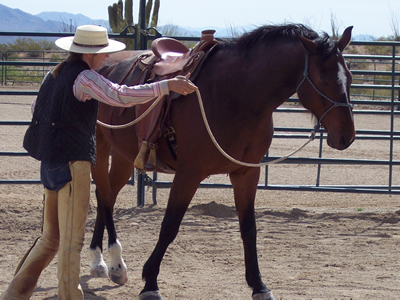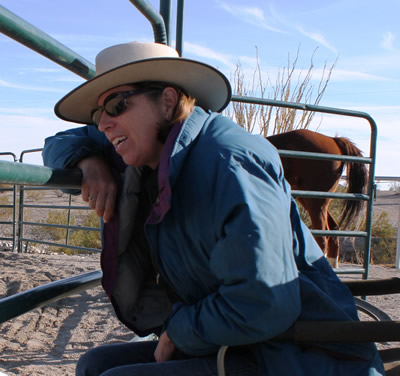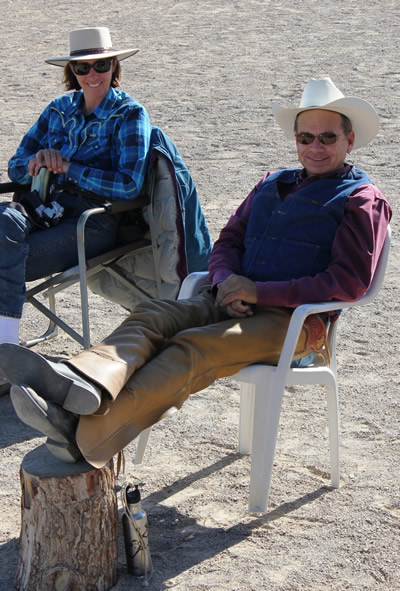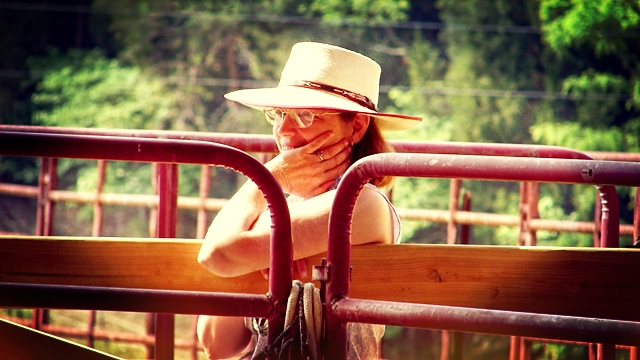Online Exclusives
Meet Libby Lyman
Horsemanship clinician, Libby Lyman, takes a rather unusual approach to reaching her students—geographically speaking. Where many clinicians make circuits around the country, or criss-cross North America in a hopscotch of clinic dates, Libby basically splits each year between Maine and California. The reasoning behind her marathon migration goes beyond the obvious summer/winter climatical challenges solved by this bi-annual cross-country haul each spring and fall.
The reasoning behind Libby’s atypical schedule is tied to an equally noteworthy personal path she trod to the role of clinician. She comes from a dressage background and taught traditional dressage in Maine for many years before being introduced to such horsemen as Ray Hunt, Joe Wolter, Bryan Neubert, and Harry Whitney. After that introduction, for years Libby tirelessly pursued opportunities to dive deep into this newfound world of horsemanship. The path led out west. Opportunities opened up including working extensively for Joe Wolter in Aspermont, Texas and staying on at Harry Whitney’s place in Salome, Arizona for several years. After this intensive education, Libby headed out on her own to teach a radically different horsemanship than what she had previously.
 “When I was working for Harry and I realized it was getting time for me to figure out what else I was going to do,” Libby says, “I didn’t know where I wanted to go or where I wanted to settle. I thought, ‘Well, you’ve got to go exploring a little bit.’ So I thought about what it was like to be a student. And one of the things that really frustrated me as a student is that I couldn’t get enough information from the good people to carry me far enough over the course of a year. They’d come, they’d spend three days, I’d get a lot, and then within a couple of months I’d be stuck and wishing that I could get to another clinic but I couldn’t because they were on the other side of the country.”
“When I was working for Harry and I realized it was getting time for me to figure out what else I was going to do,” Libby says, “I didn’t know where I wanted to go or where I wanted to settle. I thought, ‘Well, you’ve got to go exploring a little bit.’ So I thought about what it was like to be a student. And one of the things that really frustrated me as a student is that I couldn’t get enough information from the good people to carry me far enough over the course of a year. They’d come, they’d spend three days, I’d get a lot, and then within a couple of months I’d be stuck and wishing that I could get to another clinic but I couldn’t because they were on the other side of the country.”
Libby loves teaching and there was no question that she wanted to get back to teaching horsemanship—especially now that she knew she had so much more to share with students. To figure out the best way to get back into it, she thought about what changes might have been helpful along the trail while being a student herself.
“I would have liked to have had them [her mentors] around long enough to take a clinic, go home, work, and have a chance to get back with them several times in a few months. So I thought, how about if I can find a few places in the country that would host me for three or four months out of the year. I can do a little bit of training, I can do some clinics, I can take in some private lessons, so people could have options on taking advantage of the time that I was there.
“So that’s what I set out to do. For me it’s working really well. I find that people do take advantage of coming back and getting more help. They come several times through the summer if they’re people who are clinic people. In Maine I haven’t had time to take training horses but I’m taking training horses in California and I find that helps give people a leg up. And they can do a lot of lessons along with the training. It’s doing what I hoped it would. I see a significant change in the people over the years now in their education. That makes it fun.
“I come from a traditional background and I trained horses and I taught lessons my whole adult life. It was true then as well that if you take in a training horse and you bring them along and you give them back and that person has not taken lessons, the horse is going to always go to the level of the rider. But what’s different now is the work that I’m doing requires a person to be more aware of how and why the horse is doing what their doing. Why are they responding in the way that they are? It’s less technical and more philosophical. So, if you work with a horse from that perspective and send it home with a traditionally trained person, I don’t think they have much of a chance of getting along.”
Earlier in life, Libby certainly sought excellent horses, she says. She wanted performance horses that would shine in dressage tests, be capable mounts on a trail ride, and so forth. But, having truly peaceful horses and having the ability to really see how her mounts felt about things eluded her.
 “How settled they were was a goal but I didn’t understand it in the way I understand it now,” she explains. “And my horses, while they were good at going out on the trail and they were good at going to the show, they really were not settled and calm in their job and in me. They weren’t always supportable in a way I’d like to see them supportable now.”
“How settled they were was a goal but I didn’t understand it in the way I understand it now,” she explains. “And my horses, while they were good at going out on the trail and they were good at going to the show, they really were not settled and calm in their job and in me. They weren’t always supportable in a way I’d like to see them supportable now.”
Libby’s introduction to any celebrated horsemanship clinicians, let alone the group she gained access to, was very unlikely living where she did in Maine, she admits. The very tip of rural New England is about as far off the regular horsemanship clinician circuit as one can get.
“I was lucky,” she says. “Frannie and Dana Burridge up in Maine (www.piperridgefarm.com), they brought some of the best horsemen in the country to that area. Limerick is a little town in the middle of nowhere on the east side of the country where, when they started hosting clinics, hardly anyone was in a western saddle. So I got exposed to Ray Hunt and Joe Wolter, Bryan Neubert, and what they were doing. Even though they were not doing what I was doing in terms of dressage, they were doing what I wanted better than anything I’d seen before. And, it was what I had been searching for in terms of having a horse feel okay with a person. So I got lucky. I got exposed to some really good people a number of years ago and it just changed my life. I just turned and walked away from what I’d been doing and went in search of this kind of horsemanship. Frannie does a good job of bringing good people to her area.
“After I’d been at it a number of years, Harry Whitney came and did a clinic. I remember it like it was yesterday. I had a private lesson—we took my big warmblood mare that I had raised who was really troubled and he walked me through a session. By the end of the hour that mare was settled, relaxed, and following a feel. Now I’d been in clinics where I’d handed her over to the clinician and they’d work with her and gotten her in a good spot and handed her back, but I could feel her settledness drift away when I took her back. I couldn’t hold onto what had happened. I remember that ride to this day because it was absolutely profound. When it was all finished I walked away and I said, ‘That’s what I want to be able to do!’ But, I didn’t know enough about what he had walked me through to be able to replay it. So that’s when I started heading out to Arizona to study with Harry.
“I went for two winters for a month and a half, and then it worked out that I left Maine. I worked for Joe Wolter for eight months. That was a huge leg up for me in my understanding. When I left there I went to Harry Whitney’s for three years—six months out of the year he was doing clinics there and six months out of the year I was just there by myself working training horses. That kind of intensive time really helped me get a better grasp on what those guys are doing. I’m grateful that I had those opportunities, and I did my best to take advantage of them. I learned a tremendous amount, and I still am! I try to get back with those guys as often as I can and work with them. I have so much to learn still, but I love that process. I’ve never been a goal person, I’ve always been a process person. So, the process of learning and changing and growing is what fascinates me, not getting to an end result. I guess that plays into my dedication.”
 Libby fervently followed a path to get better with horses. It is a quest resulting in extensive study with several clinicians. The different lessons learned from each make up a mosaic that’s become the foundation of her own increasing abilities, but is it confusing drawing from such a pool of horsemen?
Libby fervently followed a path to get better with horses. It is a quest resulting in extensive study with several clinicians. The different lessons learned from each make up a mosaic that’s become the foundation of her own increasing abilities, but is it confusing drawing from such a pool of horsemen?
“I am a hybrid,” she says. “I’ve studied a lot with Joe Wolter. I’ve studied in clinics with Bryan Neubert. And I’ve studied probably the most with Harry Whitney, and they are not in conflict with each other. And yet they present things differently. I find that I draw from all three when teaching.
“My traditional training stressed how the horse moves. Straightness was presented from a physical standpoint – where the horse places his feet, how the body is positioned and so on. When I got started on this path, my teachers talked about the feet and movement in relationship to the horse’s body. Harry presents the work from the perspective of the horse’s mind, where his thoughts are, how his thoughts are affecting how he’s feeling. This changed everything for me. I was good at getting a horse’s body arranged to do my work, but not with the mind. A horse can do your job, and be mentally elsewhere. But this builds worry in a horse. This is not the partnership so many of us want to have.
“I remember working on the maneuver where you disengage the hind quarters and then move the front end across. Harry said to me about my mare, ‘She’s just flipping circles. Her mind has never left her buddies.’ She was light to the aids and prompt, so I thought it was good. Not so. While it’s true that if the feet are right the mind is right, it is difficult for most of us to feel when the feet are right.
“As time goes by and I dig around, I am constantly brought back to how many ways we miss how the horse is telling us it’s in trouble before the trouble gets big enough to bother us. It’s an endless process of observation. Every horse is different and yet there is so much that is the same. I left Harry with an unending curiosity to improve my awareness and ability to be dynamic within each moment with them.”
Learn more at libbylyman.com.


